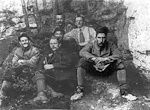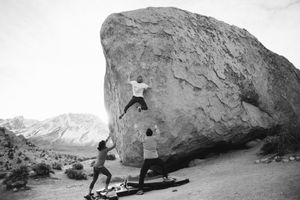Welcome to 42 DYNOS!
42DYNOS is a website for learning about climbing and exploring a curated list of resources that I've made.
History of climbing
"There are early documented examples of people "rock climbing" to achieve various objectives. The Le Quart Livre records that in 1492, ordered by his king, Antoine de Ville used castle siege tactics to ascend Mont Aiguille, a 300-meter rock tower, near Grenoble, France. In 1695, Martin Martin described the traditional practice of fowling by climbing with the use of ropes in the Hebrides of Scotland, especially on St Kilda.Rock climbing evolved in the late 19th century with bouldering in Fontainebleau,
The first ascent of Mont Blanc in 1786, started mountaineering's "modern era"...however it would take another century until the fixed anchors of rock climbing appeared, including pitons, bolts, and rappel slings..."


The main types of climbing
Bouldering consists of short routes where ropes or equipment aren't used. Bouldering problems won't exceed 6 metres commonly.


So what is a dyno?
A dyno (short for dynamic movement) is a climbing technique where a person launches themselves from one hold to another, often over a large distance. Both hands will leave the wall or hold, and often your feet will also be flying through the air. 
Who started the cult of dyno's? It's uncertain but a man named
John Gill in the 1950's is the best known for growing bouldering and dyno's.
Another aspect of dyno's is the fear, and by doing more dyno's we can learn to overcome fear and thus improve ourselves. Carlos Traversi writes this about being afraid of dyno's.
"Dynamic movements, especially into the unknown, are typically movements that push us into that cycle of irrational fear. But they also, by making us face our fear, present great opportunities for growth. There’s no better time to reset focus and flow than when executing a smooth deadpoint or dyno. Take a deep breath, let your body relax, and remember that you’ve already visualized and negated the potential risks of the next move from the ground. Eye up the next hold and go for it. Go hard, like you mean it! Go with everything you’ve got! This process will help you build confidence that you can take with you from route to route or problem to problem as you progress as a climber. So the next time you’re a little runout and the next hold is out of reach, embrace the jump—you just might surprise yourself!"Speaking of fear, what comes from the fear of the unknown? That's right, religion. Dyno's have in recent years become a symbol of something greater; they've become a religion: The Church of Dynology.

To become a disciple of The Church of Dynology one must first renounce the heathens that preach static climbing, then you must pledge your soul to the sacred slap of a successful dyno. Lastly you must post a video of yourself commiting a dyno to the subreddit r/ChurchofDynology and then you will be embraced as a true devotee of Dynology.